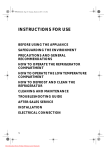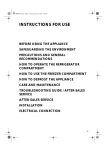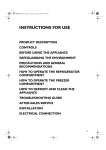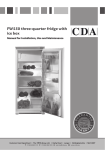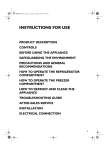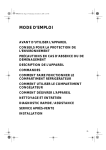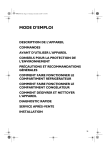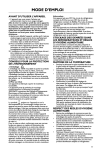Download Whirlpool WVFI-194 Troubleshooting guide
Transcript
WVFI-194/216 Gebrauchsanweisung Instructions for use Mode d’emploi Gebruiksaanwijzing Istruzioni per l’uso Instrukcje użytkowania Használati utasítás ИнструкциЯ за употреба Brugsanvisning Bruksanvisning Käyttöohje Manual de utilização Instrucciones para el uso Návod k použití Návod na použitie Instruc∑iuni de utilizare Инструкции по эксплуатации ENGLISH Instructions for use Page 4 13 4 3 INSTRUCTIONS FOR USE BEFORE USING THE APPLIANCE SAFEGUARDING THE ENVIRONMENT PRECAUTIONS AND GENERAL RECOMMENDATIONS HOW TO USE THE FREEZER CARE AND MAINTENANCE TROUBLESHOOTING GUIDE AFTER SALES SERVICE INSTALLATION ELECTRICAL CONNECTION 4 BEFORE USING THE APPLIANCE • Your new appliance is designed exclusively for domestic use. For best use of your appliance, carefully read the user handbook which contains a description of the appliance and advice on storing and preserving food. Keep this handbook for future consultation. 1. After unpacking the appliance, make sure that it is undamaged and that the doors close correctly. Any damage must be reported to the dealer within 24 hours of delivery of the appliance. 2. Wait at least two hours before switching the appliance on, to ensure that the refrigerant circuit is fully efficient. 3. Installation and the electrical connection must be carried out by a qualified technician, according to the manufacturer's instructions and local safety regulations. 4. Clean the inside of the appliance before using it. SAFEGUARDING THE ENVIRONMENT 1. Packaging The packaging material is 100% recyclable and carries the recycling symbol. For disposal, comply with the local regulations. Keep packing materials (plastic bags, polystyrene parts, etc.) out of the reach of children, as they are a potential source of danger. 2. Scrapping/Disposal The appliance is manufactured using recyclable material. This appliance is marked according to the European directive 2002/96/EC on Waste Electrical and Electronic Equipment (WEEE). By ensuring that this appliance is disposed of correctly, you are helping to prevent potentially damaging consequences for the environment and for human health. The symbol on the appliance, or on the accompanying documents, indicates that this appliance should not be treated as domestic waste but must be taken to a special collection centre for the recycling of electrical and electronic equipment. When scrapping the appliance, make it unusable by cutting off the power cable and removing the doors and shelves so that children cannot easily climb inside and become trapped. Scrap the appliance in compliance with local regulations on waste disposal, taking it to a special collection centre; do not leave the appliance unattended even for a few days, since it is a potential source of danger for children. For further information on the treatment, recovery and recycling of this product, contact your competent local office, the household waste collection service or the shop where you purchased the appliance. Information: This appliance does not contain CFCs. The refrigerant circuit contains R134a (HFCs) or R600a (HCs), see the rating plate inside the appliance. Appliances with isobutane (R600a): Isobutane is a natural gas without environmental impact but is flammable. Therefore, make sure the refrigerant circuit pipes are not damaged. This product contains Fluorinated Greenhouse Gases covered by the Kyoto Protocol, the refrigerant gas being in a hermetically sealed system. Refrigerant gas: R134a has a Global Warming Potential (GWP) 1300. Declaration of conformity • This product has been designed for preserving food and is manufactured in compliance with Regulation (CE) No. 1935/2004. • This product has been designed, manufactured and marketed in compliance with: - the safety objectives prescribed in the Low Voltage Directive 2006/95/CE (which replaced Directive 73/23/CEE as amended). - the protection requirements of the “EMC” 89/336/CEE directive, amended by Directive 93/68/CEE. • Electrical safety of the appliance can only be guaranteed if it is correctly connected to an approved earthing system. 5 PRECAUTIONS AND GENERAL RECOMMENDATIONS • During installation, make sure the appliance does not damage the power cable. • Make sure the appliance is not placed near a heat source. • To guarantee adequate ventilation, leave a space on both sides and above the appliance and follow the installation instructions. • Keep the appliance ventilation openings free. • Power cable modification or replacement must only be carried out by qualified personnel. • It must be possible to disconnect the appliance from the power supply by unplugging it or by means of a mains two-pole switch installed upstream of the socket. • Make sure the voltage specified on the rating plate corresponds to that of your home • For the water connection, use the pipe supplied with the new appliance; do not reuse the one from the previous appliance. • Install and level the appliance on a floor strong enough to take its weight and in a place suitable for its size and use. • The appliance must be handled and installed by two or more persons. • Be careful not to damage the floors when you move the appliance (e.g. parquet flooring). • Do not use single/multiple adapters or extension cords. • Install the appliance in a dry, well-ventilated place. The appliance has been configured for operation in places where the temperature falls within the following ranges, and within the climatic class given on the rating plate. The appliance may not work properly if it is left for a long time at a temperature outside the specified range. Climatic Class SN N ST T 6 Amb. temp. (°C) From 10 to 32 From 16 to 32 From 16 to 38 From 16 to 43 Amb. temp. (°F) From 50 to 90 From 61 to 90 From 61 to 100 From 61 to 110 • Do not store or use petrol, flammable liquids or gas in the vicinity of this or other electrical appliances. The vapours may cause fire or explosion. • Do not use mechanical, electric or chemical means other than those recommended by the Manufacturer to speed up the defrost process. • Do not damage the appliance refrigerant circuit pipes. • Do not use or place electrical appliances inside the product if they are not of the type expressly authorised by the Manufacturer. • This appliance is not intended for use by persons (including children) with reduced physical, sensory or mental capabilities, or lack of experience and knowledge, unless they have been given supervision or instruction concerning use of the appliance by a person responsible for their safety. Children should be supervised to ensure that they don't play with the appliance. • This appliance is not designed for use by young children or the infirm without supervision. • To avoid the risk of children becoming trapped and suffocating, do not allow them to play or hide inside the appliance. • Do not swallow the contents (non-toxic) of the ice packs (where provided). • Use the refrigerator compartment to store fresh food only and the freezer compartment to store frozen food, to freeze fresh food, and to make ice cubes only. • Do not store glass containers with liquids in the freezer since they may burst. • Do not eat ice cubes or ice lollies immediately after taking them out of the freezer since they may cause cold burns. • Before carrying out any maintenance or cleaning, unplug the appliance or disconnect it from the power supply. • All appliances equipped with an ice-maker and water dispenser must be connected to a water supply that only delivers drinking water (with mains water pressure of between 0.17 and 0.81 Mpascals (1.7 and 8.1 bar)). Ice-makers and/or water dispensers not directly connected to the water supply must be filled with drinking water only. • The Manufacturer declines any liability if the above advice and precautions are not respected. HOW TO USE THE FREEZER The freezer can be used for storing already frozen food and for freezing fresh food. Switching on the freezer for the first time • There is no need to set the freezer temperature on the thermostat because the appliance is already factory set. • Plug in the appliance. • The alarm signal activates, indicating that the freezer has not yet reached a sufficiently cold temperature for storage of foodstuffs. • Only place food in the freezer once the alarm signal has deactivated (for further details, see the enclosed product sheet). Temperature Adjustment For temperature adjustment, see the enclosed product sheet. Note: Ambient air temperature, the frequency of door opening and the position of the appliance can affect the freezer internal temperature. Take these factors into consideration when setting the thermostat knobs. “6th Sense” function The 6th Sense function, if present, is automatically activated in the following cases: Door opening The function activates when door opening causes the internal temperature to increase to values that do not ensure safe storage of food and remains active until optimal storage conditions have been restored. Placing fresh food in the freezer The function activates when fresh food is placed in the freezer and remains active until optimal freezing conditions are reached so as to ensure the best freezing quality with the lowest power consumption. NOTE: Besides the quantity of food loaded into the freezer, ambient temperature and the quantity of food already inside the freezer affect the duration of the 6th Sense function. Therefore significant duration variations are quite normal. Freezing The amount of fresh food (in kg) that can be frozen in 24 hours is indicated on the appliance data plate. For optimum appliance performance, press the fast freeze button (until the yellow LED lights up) 24 hours before placing fresh food in the freezer. After placing fresh food in the freezer, 24 hours on fast freeze function is generally sufficient; After 24 hours, deactivate the fast freeze function Attention: In order to save energy, when freezing small amounts of food, the fast freeze function can be deactivated after a few hours. If the 6th Sense function is present, appliance operation is controlled automatically and no operation is required (see chapter “6th Sense” function) 7 Tips for freezing and storing fresh food. • Before freezing, wrap and seal fresh food in: aluminium foil, cling film, air and water-tight plastic bags, polythene containers with lids or freezer containers suitable for freezing fresh food. • Food must be fresh, mature and of prime quality in order to obtain high quality frozen food. • Fresh vegetables and fruit should preferably be frozen as soon as they are picked to maintain the full original nutritional value, consistency, colour and flavour. Some meat, especially game, should be hung before it is frozen. Note: • Always leave hot food to cool before placing in the freezer. • Eat fully or partially defrosted foods immediately. Do not refreeze unless the food is cooked after it has thawed. Once cooked, the thawed food can be refrozen. Freezing and storing fresh food • Place foods to be frozen in the baskets. • Place the ice packs (if supplied) above the food stored in the top compartment. • In models with ice packs, in the event of a power failure, place the ice pack/s above the food stored in the top compartment, in order to optimise the rising time and therefore maintain correct food preservation. Important: The table alongside shows the recommended maximum storage time for frozen fresh foods. Declared performance refers to appliance operation without ice packs, with the exception of the rising time. Classification of frozen foods Put the frozen products into the freezer and classify them. The storage date should be indicated on the packs, to allow use within expiry dates. Advice for storing frozen food When purchasing frozen food products: • Ensure that the packaging is not damaged (frozen food in damaged packaging may have deteriorated). If the package is swollen or has damp patches, it may not have been stored under optimal conditions and defrosting may have already begun. • When shopping, leave frozen food purchases until last and transport the products in a thermally insulated cool bag. • Once at home, place the frozen foods immediately in the freezer. • If food has defrosted even partially, do not re-freeze it. Consume within 24 hours. • Avoid, or reduce temperature variations to the minimum. Respect the best-before date on the package. • Always observe the storage information on the package. 8 MONTHS FOOD Removing the baskets • Pull the baskets out fully, then lift them up slightly in order to remove. Drawers (except the bottom drawer) may be removed in order to obtain increased storage space (Fig. 1) Ensure that the load does not exceed the limit (if present) indicated on the side walls of the appliance. Please follow the storage times given on the frozen food packages. Fig. 1 Making ice cubes • Fill the ice cube tray 2/3 full and place it in the special freezer compartment. • Do not use sharp or pointed instruments to detach the tray if it is stuck to the bottom of the freezer. • Bend the ice tray slightly to remove the cubes. Note: The freezer door will not re-open easily immediately after closing (except for the models with specific valve). Wait a few minutes before opening again in order to allow for compensation of the vacuum created. Intelligent ice system with feeder Some models are equipped with an ice system including a feeder, ice cube trays with removal device and ice bin. Thanks to this system, it is easy to fill the ice cube trays with water, remove the ice cubes and store them. The feeder allows you to easily fill the trays with water without having to remove them from the freezer and without spilling water on the kitchen floor. Filling the trays with water: • before filling the trays, clean them as described in the cleaning section. • To remove the feeder, pull it towards you. • Fill the feeder with water without resting it on a surface, then refit it on its support. The water will automatically fill the ice cube trays. • Wait for a few hours for the ice to be ready, then turn the knobs to extract the ice cubes. The ice cubes will fall directly into the ice bin. Attention: • make sure there are no ice cubes in the tray before refitting the feeder. • Before refitting the feeder, make sure there is no ice on the springs; if there is, remove it under running water. • The removable parts of the ice system may be taken out in order to obtain increased storage space. 9 CARE AND MAINTENANCE Before any cleaning or maintenance operation, unplug the appliance from the mains or disconnect the electrical power supply. For electronic models, first press the on/off button and then unplug the the appliance. Periodically clean the condenser at the rear of the appliance with a vacuum cleaner or brush. Periodically clean the inside of the compartment with a sponge dampened in warm water and/or neutral detergent. Rinse and dry with a soft cloth. Do not use abrasive products Long vacation • Empty the freezer. • Disconnect the freezer from the mains power supply. • Defrost and clean. Leave the door open to prevent formation of unpleasant odours and to eliminate any dampness Note: for electronic models, first insert the power plug into the mains socket and then press the on/off button to switch on the appliance. TROUBLESHOOTING GUIDE When you hear these noises ..your appliance is alive!!! 1. • • • • The appliance is no working. Is there a power failure? Is the plug properly inserted in the socket? Is the double-pole switch on? Do the household electrical system protection devices work correctly? • Is the power cord damaged? 2. Excessive frost build-up. •Has the defrost water drain been positioned correctly? •Is the door shut properly? 10 3. The yellow, red and green LEDs do not light up. Perform the checks for point 1, and then: •Contact After Sales Service. Notes: • The front edge of the appliance may be hot. This prevents the formation of condensation and is not a defect. • Gurgling and hissing noises due to expansion in the refrigerant circuit are normal. AFTER SALES SERVICE Before contacting After Sales Service: 1. See if you can solve the problem yourself with the help of the Troubleshooting guide. 2. Switch the appliance on again to see if the problem has been solved. If it has not, disconnect the appliance from the power supply and wait for about an hour before switching on again. 3. If the problem persists after this course of action, contact After-sales Service. Specify: •the nature of the fault, •the model, •the Service number (the number after the word SERVICE on the rating plate on the inside of the appliance), •your full address, •your telephone number and area code. Note: The direction of door opening can be changed. If this operation is performed by After-sales Service it is not covered by the warranty. The door cannot be reversed on models with front handle. INSTALLATION • Install the appliance away from heat sources. Installation in a hot place, near heat sources (radiators, cookers) or direct exposure to the sun will increase energy consumption and should be avoided. • If this is not possible, respect these minimum distances: - 30 cm from coal or oil stoves; - 3 cm from electric and/or gas cookers. • For optimum operation, ensure: - a space of at least 5 cm above the appliance; - a distance of at least 4 cm from the rear wall; - place other cabinets at a suitable distance from the appliance to allow at least some air circulation • Install the appliance level (adjust the front feet if necessary) in a dry and well-aired place. • Clean the inside. • Insert the accessories supplied. Electrical connection • The electrical connections must comply with the local regulations. • Voltage and power input are specified on the rating plate inside the appliance. • Regulations require the appliance to be earthed. The manufacturer declines any liability for injury or damage resulting from failure to observe the above rules. • If the plug and socket are not of the same type, have the socket replaced by a qualified technician. • Do not use extension leads or multi-adapters. Electrical disconnection It must be possible to electrically disconnect the appliance by unplugging it or by means of a double-pole switch installed ahead of the socket. 11 ELECTRICAL CONNECTION 1) For Great Britain only Warning - this appliance must be earthed Fuse replacement If the mains lead of this appliance is fitted with a BS 1363A 13amp fused plug, to change a fuse in this type of plug use an A.S.T.A. approved fuse to BS 1362 type and proceed as follows: 1. Remove the fuse cover (A) and fuse (B). 2. Fit replacement 13A fuse into fuse cover. 3. Refit both into plug. Important: The fuse cover must be refitted when changing a fuse and if the fuse cover is lost the plug must not be used until a correct replacement is fitted. Correct replacement are identified by the colour insert or the colour embossed in words on the base of the plug. Replacement fuse covers are available from your local electrical store. 2) For the Republic of Ireland only The information given in respect of Great Britain will frequently apply, but a third type of plug and socket is also used, the 2-pin, side earth type. 3) Socket outlet / plug (valid for both countries) If the fitted plug is not suitable for your socket outlet, please contact Whirlpool Service for further instruction. Please do not attempt to change plug yourself. This procedure needs to be carried out by a qualified Whirlpool technician in compliance with the manufactures instructions and current standard safety regulations. 12 20 19 18 17 16 15 14 13 11 10 9 8 7 6 5 4 4 13 ENGLISH 3 Instructions for use Page 4 5019 303 02021 GB IL AE n Whirlpool is a registered trademark of Whirlpool, USA 07/10 © Copyright Whirlpool Europe s.r.l. 2010. All rights reserved - http://www.whirlpool.eu
































